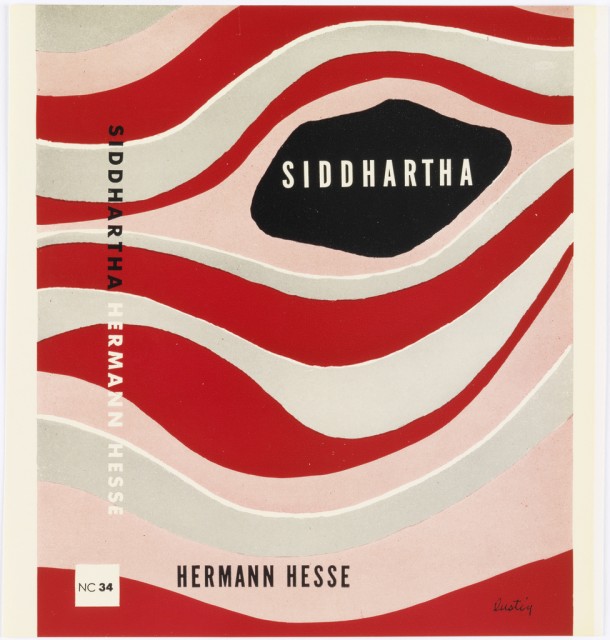“Dreams and restless thoughts came flowing to him from the river… When Siddhartha awoke, the pale river shimmered past the door…The broad sheet of water glimmered pink in the light of the morning…’Yes’, said the ferryman, ‘it is a very beautiful river…I have often listened to it, gazed at it… One can learn much from a river’.”[1]
Siddhartha’s life in Herman Hesse’s novel flows like a river, its essence captured in Alvin Lustig’s book jacket design. Siddhartha’s spiritual quest leads him to the Samanas, “lean jackals in the face of men,”[2]2 who practice extreme self-sacrifice to become one with the universe. Unable to achieve complete self-forgetting with the Samanas, Siddhartha next tries worldly pleasures. Yearning still, he traverses a river, its gurgling becoming distinct voices, as familiar faces appear in the water. When Siddhartha despairs, the river beckons him to death. Ultimately, however, he finds “Om-perfection” in the river, “…surrendering himself to the stream, belonging to the unity of all things.”[3] The river thus becomes a figure for Siddhartha’s spiritual quest, guiding him to the perfection of the present moment: “…the river is everywhere at the same time… at the current, in the ocean and in the mountains, everywhere, and…the present only exists for it, not the shadow of the past, nor the shadow of the future.”[4]
Within this movement, in both novel and book jacket image, there is a counter-rhythm, figured as the black weight of a stone dropping into water: “When you throw a stone into the water, it finds the quickest way to the bottom… It is the same when Siddhartha has an aim, a goal…he is drawn and lets himself fall… everyone can reach his goal, if he can wait, can think, can fast.”[5]5 Lustig’s image captures the forces of flow and interruption through the aerially-viewed horizontal river and the vertical stone. White letters further impel the black form downwards.
Here, as in Lustig’s other book jacket designs, he responds abstractly to the text, not embracing literal depiction. Embodying a river’s essence, the image suggests alternate readings too, including an eye with contours of energy emanating along the curves of a face. As a painter of transitory reflections in water and glass, and of faces too, I am transfixed by Lustig’s image, and lulled towards new insight into Hesse’s text.
[1]Siddhartha by Hermann Hesse. New York: New Directions, 1951, pp. 5, 51.
[2] Ibid, p. 9.
[3] Ibid, p. 139.
[4] Ibid, p. 109.
[5] Ibid, pp. 63-64.
